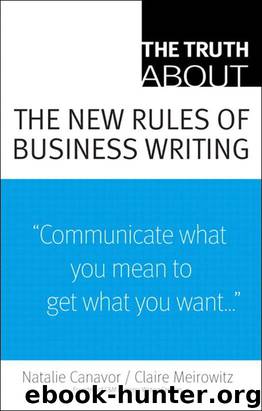The Truth About the New Rules of Business Writing by Canavor Natalie & Meirowitz Claire

Author:Canavor, Natalie & Meirowitz, Claire [Canavor, Natalie]
Language: eng
Format: mobi
Publisher: Pearson Education (US)
Published: 2009-12-15T16:00:00+00:00
Truth 27. Letters build relationships
Writing a letter of introduction—One of us recently got a snail-mail letter from a doctor who’d taken over a retired doctor’s practice and wanted to keep his predecessor’s patients. He began:
I would like to take this opportunity to introduce myself. I am a board certified dermatologist practicing in this area since 2002. I trained at…
And on with more than a page of credentials and a list of dermatology diseases he’s treated that, well, made our skin crawl. The writing is technically fine but fails utterly. It’s the message that doesn’t work—why not?
The doctor appears to have been writing to impress his peers, not prospective patients. Had he considered his audience’s concerns, he might have come up with a content map that includes: I’m a warm, comfortable guy who cares about his patients…my office will be run efficiently and respectfully…and I’m a very good doctor. The writer doesn’t actually need to say he’s a warm person, but he needs to demonstrate it in his writing tone. For example:
Dear Ms. White:
As you know, Dr. Andrew Grant retired in June, and I am taking over his practice. I don’t know you yet personally but want to introduce myself. In addition to bringing strong experience and credentials to Hartley Street Medical, I plan to provide a comfortable, responsive environment…
Notice that once we take the trouble to produce a good lead, the rest readily falls into place. The basic information can be categorized (for example, training, experience, local connections). It is perfectly okay to use subheads or bold lead-ins in a letter, and/or bullets. A good business letter does not necessarily require a narrative flow all the way through.
Of course, a personal salutation and real signature help personalize a letter.
A resignation letter—Suppose you’ve got a new job and it’s time to resign from your old one. Do yourself a favor—don’t use e-mail for this! Usually it’s best to tell your immediate superior in a private meeting and follow up with a formal letter. It will circulate through company channels and be filed forever, remember. So formal business style is the way to go.
What’s your goal? Don’t make it revenge: It’s human to think about getting even for all the small snubs, resentments, and relationship issues that develop over time. But that’s the fantasy—you’re the grownup and have to do what’s best for you in the long run.
Your goals in 90 percent of leave-taking situations should be…
• To ensure you get good references every time you consider a new opportunity.
Download
This site does not store any files on its server. We only index and link to content provided by other sites. Please contact the content providers to delete copyright contents if any and email us, we'll remove relevant links or contents immediately.
Nudge - Improving Decisions about Health, Wealth, and Happiness by Thaler Sunstein(7499)
Deep Work by Cal Newport(6840)
Principles: Life and Work by Ray Dalio(6160)
Factfulness: Ten Reasons We're Wrong About the World – and Why Things Are Better Than You Think by Hans Rosling(4650)
The Doodle Revolution by Sunni Brown(4644)
Eat That Frog! by Brian Tracy(4403)
Thinking in Bets by Annie Duke(4132)
Hyperfocus by Chris Bailey(4021)
Visual Intelligence by Amy E. Herman(3704)
Writing Your Dissertation in Fifteen Minutes a Day by Joan Bolker(3655)
How to Win Friends and Influence People in the Digital Age by Dale Carnegie & Associates(3479)
Ogilvy on Advertising by David Ogilvy(3474)
Hidden Persuasion: 33 psychological influence techniques in advertising by Marc Andrews & Matthijs van Leeuwen & Rick van Baaren(3432)
How to win friends and influence people by Dale Carnegie(3369)
The Pixar Touch by David A. Price(3341)
Schaum's Quick Guide to Writing Great Short Stories by Margaret Lucke(3293)
Deep Work: Rules for Focused Success in a Distracted World by Cal Newport(3095)
Work Clean by Dan Charnas(3021)
The Slow Fix: Solve Problems, Work Smarter, and Live Better In a World Addicted to Speed by Carl Honore(2925)
